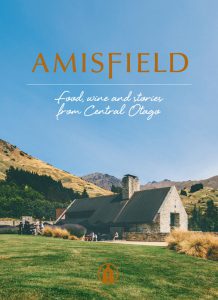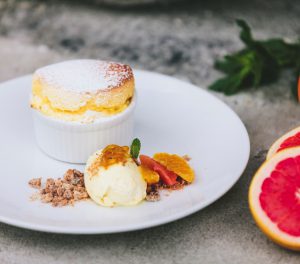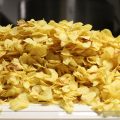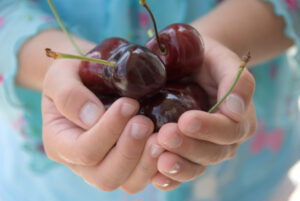 Hot off the press is Amisfield, Food and Wine stories from Central Otago Lovers of good wine will be familiar with the Amisfield Pinot Noir and aromatic white wines, while travellers to Central Otago would seldom leave without stopping at the multi award winning Amisfield winery restaurant, perched on the rise above Lake Hayes only a short drive from Queenstown and Arrowtown.
Hot off the press is Amisfield, Food and Wine stories from Central Otago Lovers of good wine will be familiar with the Amisfield Pinot Noir and aromatic white wines, while travellers to Central Otago would seldom leave without stopping at the multi award winning Amisfield winery restaurant, perched on the rise above Lake Hayes only a short drive from Queenstown and Arrowtown.
Amisfield the book, embraces both the Central Otago history, the winery and of course their stunning fare that makes Amisfield a popular destination for both travellers and locals.
With 100 of their signature recipes to share, it now means that those of us who pine for duck rillette with pinot cherries, Stewart island salt cod brandade and Goat’s cheese agnolotti, to name but a few, will now have the chance to reproduce them in our own kitchens.
English muffins from the Bread and Bakery chapter are top of my list to try followed pretty closely by the citrus souffle and beef cheeks below.
Whether you are a passionate cook or someone who appreciates beautiful books, Amisfield is certainly worth adding to your collection and an ideal book for a quiet weekend afternoon in a cosy chair.
For a chance to win one of two copies of Amisfield visit our win pages.
citrus souffle, whipped mascarpone, roasted white chocolate
Serves 10
 This is a simple, light dessert that is best served the day the soufflé batter is made.
This is a simple, light dessert that is best served the day the soufflé batter is made.
The roasted white chocolate adds a crunchy texture and caramelised flavour to the soufflé, and the whipped mascarpone is a cooling addition to balance with the hot dessert. We like to serve this dish with freshly segmented grapefruit and orange, and garnish it with mint.
Roasted white chocolate
200 g white chocolate
Citrus soufflé
butter and sugar to prepare ramekins
60 g butter
60 g flour
100 ml lemon juice
100 ml orange juice
zest of 2 lemons and 2 oranges
8 large eggs, separated
90 g sugar
Whipped mascarpone
200 g mascarpone
¼ cup lemon juice
zest of 1 lemon and 1 orange
1 tbsp sugar
½ vanilla pod, split and seeds scraped
To serve
grapefruit and blood orange segments
1 handful of mint leaves
icing sugar for dusting
For the roasted white chocolate
Preheat the oven to 150ºC.
Melt the white chocolate in a bowl over a saucepan of simmering water. Pour the melted white chocolate into a small, shallow roasting pan and bake for 5 minutes.
Remove the chocolate from the oven, give it a stir, then return it to the oven for another 5–10 minutes, occasionally pulling it out to stir.
Allow the chocolate to reach a dark golden colour before cooling at room temperature. The chocolate will have a crumbled texture.
For the soufflé
Preheat the oven to 190ºC. Grease 10 ramekins with softened butter and dust them with sugar. Be sure not to leave any surfaces uncovered as this will prevent the soufflé from rising evenly.
Melt the butter in a saucepan. Add the flour and whisk until combined. While whisking slowly, add the citrus juices and zest to the pan over the heat. Cook until a thick paste forms, then take off the heat.
In a large bowl whisk the egg yolks and sugar together rapidly by hand until light yellow. Whisk in the butter and flour paste and set aside.
Whip the egg whites in a stand mixer fitted with a whisk attachment on high speed until stiff and white. Fold the whites into the citrus mixture and immediately spoon into the prepared ramekins.
Bake for approximately 15 minutes at 190ºC. Reduce the oven temperature to 175ºC and cook for a further 5–7 minutes until the soufflés are golden brown.
For the mascarpone
Place all the ingredients in a stand mixer fitted with whisk attachment and whip on high speed for 5 minutes until fluffy. Then pass the mixture through a fine strainer to make a smooth cream.
To serve
Spoon some of the chocolate onto the plate, top with whipped mascarpone, and garnish with grapefruit and orange segments or any fruits that are in season, and mint. Place a napkin or serviette on the plate where the soufflé will sit. Dust soufflé with icing sugar and serve immediately.
Braised beef cheeks, celeriac purée, crispy parsnip, sage, grated horseradish
 Serves 6
Serves 6
We grow horseradish in the Amisfield garden – there’s nothing like it. Make sure the oven is hot and baste the cheeks frequently at the end to ensure that lovely dark stickiness.
Braised beef cheeks
1.5 kg beef cheeks
salt to taste
2 onions, roughly chopped
2 carrots, roughly chopped
2 celery sticks, roughly chopped
250 ml Amisfield pinot noir
1 bunch of thyme sprigs
Celeriac purée
2 heads of large celeriac, peeled and cubed
1 handful of thyme sprigs
200 ml water
juice of 1 lemon
100 ml olive oil
salt
Crispy parsnip
1 litre canola oil for deep-frying
1 parsnip, peeled
To serve
crispy sage leaves (see page 272)
freshly grated horseradish to taste
For the beef cheeks
Prepare the cheeks the day before.
Preheat the oven to 90ºC.
Season the beef cheeks with salt and brown them in a frying pan. Do this in batches so you don’t overcrowd the pan. Put the browned beef cheeks in a deep roasting pan.
Add the onion, carrots and celery to the frying pan and cook for 3 minutes on medium heat. Place the vegetables on top of the beef cheeks.
Take the frying pan off the heat and add the wine. Return to the heat and bring to a simmer for about 2 minutes. Pour the wine into the roasting pan, and add the thyme. Add enough warm water to just cover the beef cheeks and cover with baking paper and aluminium foil. Place in the oven for 12 hours.
The cooking time can change depending on the size of the cheeks. You want the cheeks to be tender but not completely falling apart. Once the cheeks are cooked remove from the oven and rest them in the braising liquid at room temperature until cooled. Remove the cheeks from the liquid and cool in the fridge. Once the cheeks are completely chilled, cut in half lengthwise.
Preheat the oven to 200ºC.
Strain the braising liquid into an ovenproof pan large enough to hold the beef cheeks. Reduce by a third, skimming the fat off the surface as it reduces. Add beef cheeks and place in the oven for 20 minutes, or until the liquid has reduced to a sticky glaze, basting every 3–4 minutes.
For the purée
Preheat the oven to 150ºC.
Place the celeriac, thyme and water in a roasting pan, cover with aluminium foil and cook for 1 hour. Remove the foil and return the pan to the oven for another 30 minutes. Remove from the oven and pick out all the thyme.
Transfer the celeriac to a blender with the lemon juice and blend. With the motor running, drizzle in the olive oil. Season with salt. Pass the purée through a fine mesh sieve.
For the parsnip
Heat the canola oil in a saucepan to 180ºC.
Peel strips of parsnip in long ribbons until you reach the core. Fry in batches until golden brown and then drain on paper towels to absorb the excess oil.
To serve
Place the celeriac purée in the centre of the dish, place the beef cheeks around the purée and carefully pour on the glaze so as not to cover the purée. Garnish with fried parsnip, crispy sage leaves and freshly grated horseradish.
Crispy sage leaves
50 g butter
1 handful of sage leaves
Heat the butter in a frying pan over medium heat until the milk solids turn dark brown, creating a deep caramelised flavour and colour.
Crisp the sage leaves in the brown butter and drain on a paper towel.
Recipes shared with permission.
Amisfield, Food, wine and stories from Central Otago.
RRP $60





